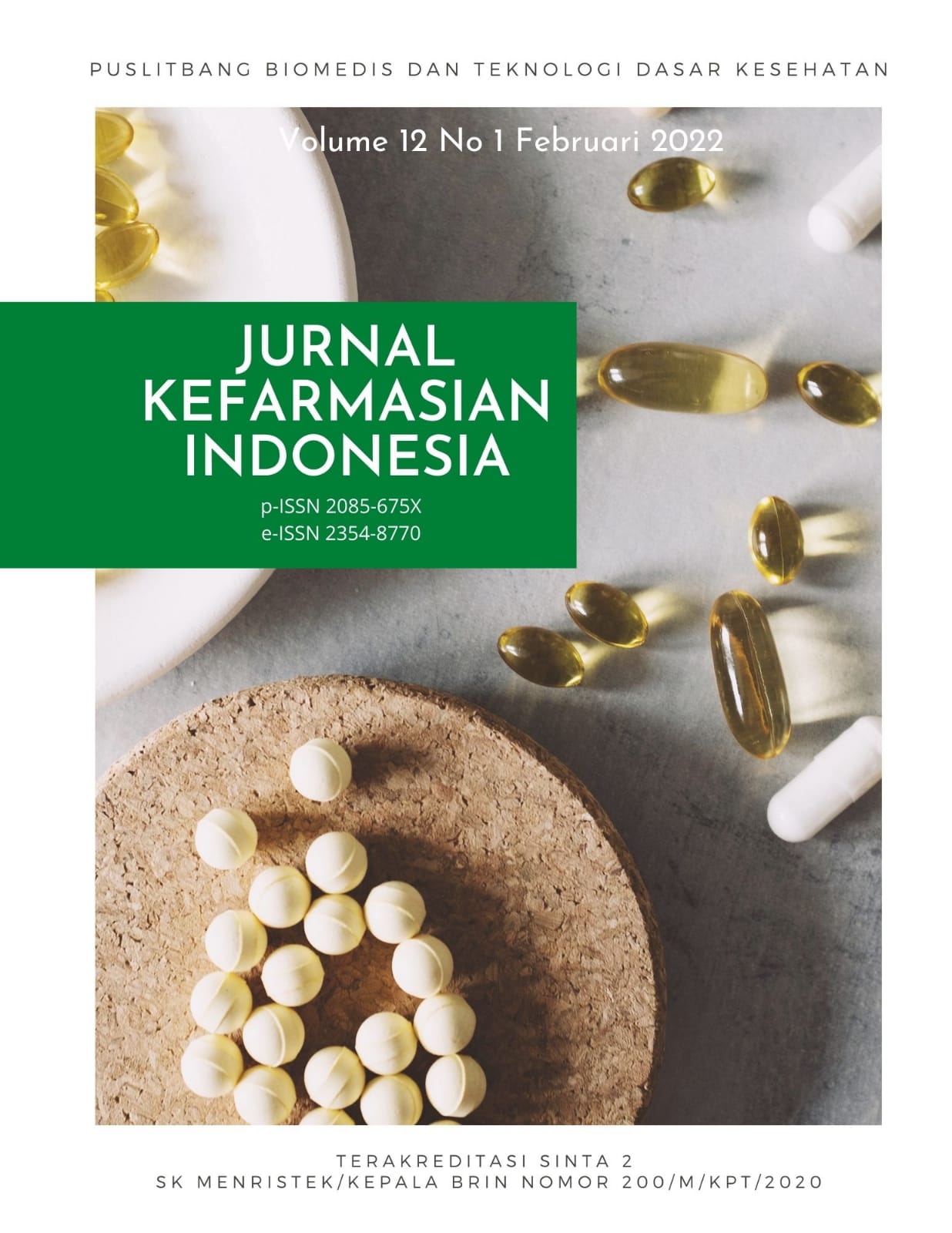Aktivitas Ramuan Herbal sebagai Antagonis Reseptor H1, Relaksan Otot Polos dan Penghambat Degranulasi Sel Mast sebagai Antiasmatik
Abstract
Asthma is still become a major health problem worldwide, affected all ages from pediatrics to adults. The severity of the disease vary from mild to severe and leads to the risk of death. The uses of medicinal plants as antiasthmatic have often been conducted by the local community. The present study was conducted in vitro and in vivo to determine the activities of herbs containing of sembung leaves (Blumea balsamifera L.), kemukus seeds (Piper cubeba L.), teki rhizome (Cyperus rotundus L.), and patikan kebo herbs (Euphorbia hirta L.) with certain ratio as an antiasthmatic. The in vitro test was carried out on isolated smooth muscle cells of guinea pig. Histamine was used to stimulate the contraction of smooth muscle cells of guinea pig trachea. The in vivo test was carried out using guinea pigs which sensitized with ovalbumin and administered with the herbs formula. The trachea of guinea pigs were prepared for histopathological examination and stained on toluidine blue. The result revealed that the antiasthmatic herbs of 1, 2, and 3 showed activities as H1 receptor antagonists. The antiasthmatic herbs of 1, 2, and 3 were able to relax the smooth muscle of guinea pig’s trachea that was experiencing contraction, but in lower level compared to theophylline. The antiasthmatic herbs formula in this study did not have the activity to inhibit mast cell degranulation.References
Kementerian Kesehatan RI. Penderita asma di Indonesia. Jakarta: InfoDATIN Kemenkes RI; 2019. 1.
GAN. The global asthma report 2018. Auckland New Zealand: The Global Asthma Network; 2018. 6–13 p.
Kementerian Kesehatan RI. Hasil utama Riskesdas 2018 [Internet]. 2018 p. 51. Available from: http://www.depkes.go.id/resources/download/info-terkini/hasil-riskesdas-2018.pdf.
Kumar S, Malhotra R, Dinesh Kumar. Euphorbia hirta: its chemistry, traditional and medicinal uses, and pharmacological activities. Pharmacogn Rev. 2010;4(7):58–61.
Yuet Ping K, Darah I, Chen Y, Sreeramanan S, Sasidharan S. Acute and subchronic toxicity study of Euphorbia hirta L. methanol extract in rats. Biomed Res Int. 2013;2013:182064. doi: 10.1155/2013/182064.
Wahyono, Hakim L, Wahyuono S, Mursyidi A, Verpoorte R, Timmerman H. Isolasi senyawa tracheopasmolytic dari buah Piper cubeba isolat. Maj Farm Indones. 2003;14(3):119–23.
Jin JH, Lee DU, Kim YS, Kim HP. Anti-allergic activity of sesquiterpenes from the rhizomes of Cyperus rotundus. Arch Pharm Res. 2011;34(2):223–8.
Chen Y, Er H. Antioxidant, anti-proliferative and bronchodilatory activities of Euphorbia hirta extracts. Malaysian J Sci [Internet]. 2010;29(1). Available from: https://mjs.um.edu.my/article/view/7616.
Yamauchi K, Ogasawara M. The role of histamine in the pathophysiology of asthma and the clinical efficacy of antihistamines in asthma therapy. Int J Mol Sci. 2019;20(7).
Departemen Kesehatan RI. Farmakope Indonesia Edisi III. Jakarta; 1979.
Nugroho AE, Anas Y, Arsito P, Wibowo J, Riyanto S, Sukari M. Effects of marmin, a compound isolated from Aegle marmelos Correa, on contraction of the guinea pig-isolated trachea. Pak J Pharm Sci. 2011;24(4):427–33.
Vogel. HG, H.Vogel W, Schölkens BA, Sandow J, Günter M, Vogel WF, editors. Drug discovery and evaluation edited by HG Vogel and WH Vogel. Second Edition. Vol. 17, Human & experimental toxicology. Berlin: Springer Berlin Heidelberg; 2002. 351–4 p.
Nugroho AE, Wibowo JTRI, Riyanto S. Marmin, a compound from Aegle marmelos Corr., relaxes the ovalbumin-induced contraction of trachea. Int J Pharm Pharm Sci. 2012;4(1):479–84.
Abdel-Haq H, Palmery M, Leone MG, Saso L, Silvestrini B. Relaxant effects of aflatoxins on isolated guinea pig trachea. Toxicol Sci. 2000;55(1):162–70.
Mahajan SG, Mehta AA. Suppression of ovalbumin-induced Th2-driven airway inflammation by β-sitosterol in a guinea pig model of asthma. Eur J Pharmacol [Internet]. 2011;650(1):458–64. Available from: http://dx.doi.org/10.1016/j.ejphar.2010.09.075
Nugroho AE, Arsito PN, Anas Y, Wibowo JT, Riyanto S, Sukari MA. Antagonisme marmin terhadap reseptor 5-hidroksi triptamin dan reseptor histamin pada otot polos ileum marmut (antagonism of marmin on 5-hydroxytriptamine and histamine receptors in guinea-pig ileum smooth muscle). J Ilmu Kefarmasian Indones. 2011;9(2):110–5.
Williams DM, Rubin BK. Clinical pharmacology of bronchodilator medications. Respir Care. 2018;63(6):641–54.
Nugroho AE, Wahyono W, Wahyuono S, Maeyama K. Effects of dihydrocubebin, a lignan isolated from Indonesian plant Piper cubeba, on the histamine release from rat mast cells. Orient Pharm Exp Med. 2010;10(3):200–7.
Chang HC, Gong CC, Chan CL, Mak OT. A nebulized complex traditional Chinese medicine inhibits histamine and IL-4 production by ovalbumin in guinea pigs and can stabilize mast cells in vitro. BMC Complement Altern Med [Internet]. 2013;13(1):1. Available from: BMC Complementary and Alternative Medicine
Copyright (c) 2022 Jurnal Kefarmasian Indonesia

This work is licensed under a Creative Commons Attribution-NonCommercial-ShareAlike 4.0 International License.














